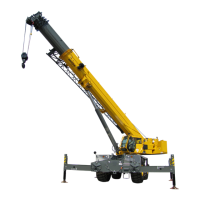LUBRICATION 1300A
8-4 01-22-2019 Control # 051-08
The following describe the lubrication points and gives the
lube type, lube interval, lube amount, and application of
each. Each lubrication point is numbered, and this number
corresponds to the index number shown on the Lubrication
Chart (Figure 8-1). Lube description and symbols are found
in the table below.
LUBRICATION POINTS
A regular frequency of lubrication must be established based
on component operating time. The most efficient method of
keeping track of lube requirements is to maintain a job log of
crane usage.
All oil levels are to be checked with the crane parked on a
level surface in transport position, and while the oil is cold,
unless otherwise specified. On plug type check points, the oil
levels are to be at the bottom edge of the fill port.
Over lubrication of non-sealed fittings does no harm, but
under lubrication shortens lifetime. Worn grease fittings that
do not hold a grease gun, or those that have a stuck check
ball, must be replaced.
When wear pads or rotation bearings are lubricated, cycle
the components and lubricate again to ensure complete
lubrication of the entire wear area.
Symbol Description
National Crane Lube Specification
Standard
Cold Weather -
40°C (-40°F)
AFC Antifreeze/Coolant (for Cab Heater) 6829101130 6829104212
EP-MPG Extreme Pressure Multipurpose Grease 6829003477 6829104275
GL-5 GL-5 Gear Lubricant 6829012964 6829014058
HYDO Hydraulic Oil 6829006444 6829006993
EP-OGL Open Gear Lubricant, CEPLATTYN 300 Spray, NLGI Grade 1-2 6829102971 6829102971
AGMA EP-4 Extreme Pressure Gear Lubricant. 6829100213 6829103636
WRL Wire Rope Lubricant 6829015236 6829010993
EO-20W-20 Engine Oil (Light non-EP Oil), Mil-L-46152 6829005570 -
TES 295 TES295 Compliant Fluid - 6829101690
NOTE: Cold weather lubricants are not sufficient for temperatures below 40° C (-40° F). Use hydraulic tank heaters and
insulate where appropriate.
CAUTION
Lubrication intervals (4) are to be used only as a guide.
Actual intervals should be formulated by the operator to
correspond accordingly to conditions such as continuous
duty cycles and/or hazardous environments.

